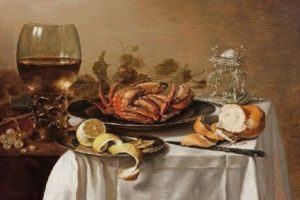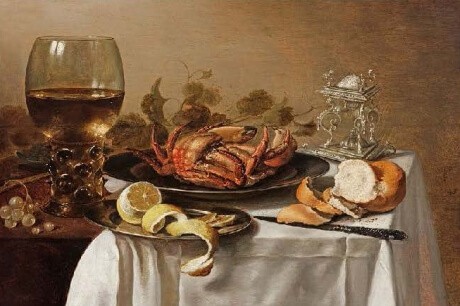Our obsession with looking at tasty, exotic food, it turns out, is not just a social media fad. The abundance of #foodporn posts popular on Instagram may signify a longstanding fascination with edible decadence that would have been as familiar to Renaissance master painters as foodies of today.
Cornell Food and Brand Lab researchers teamed with Andrew Weislogel, the Seymour R. Askin Jr. ’47 Curator of Earlier European and American Art at Cornell’s Herbert F. Johnson Museum of Art, to analyze the contents of 500 years of European and American food paintings. The researchers found indulgent, rare and exotic foods were historically popular in paintings despite being foods not readily available to the average family living at that time.
“Our love affair with visually appealing, decadent or status foods is nothing new,” said Weislogel. “It was already well-established 500 years ago.”
Brian Wansink, director of the Cornell Food and Brand Lab and the John S. Dyson Professor of Marketing in the Dyson School of Applied Economics, along with former Food and Brand Lab researcher Anupama Mukund and Weislogel, analyzed 140 European and American food paintings created between 1500 and 2000. The study was published July 19 in Sage Open.
The researchers found that 76 percent of all the meals depicted included fruits, especially lemons. Only 19 percent contained vegetables, with the artichoke appearing most frequently. Over 54 percent showed bread and pastries and 39 percent contained meat or seafood, often lobster. Salt was the most commonly depicted seasoning and cheese the most common dairy product.
The foods depicted in the past 500 years of art are not so much a representation of what people commonly ate, but a reflection of the aspirational nature of food in society.
 “Aspirational foods are those foods that are expensive, hard to find, or exotic,” Wansink said. “Painting them could have been a way to show status or good-taste. Over-the-top meals with unusual ingredients aren’t a modern invention.”
“Aspirational foods are those foods that are expensive, hard to find, or exotic,” Wansink said. “Painting them could have been a way to show status or good-taste. Over-the-top meals with unusual ingredients aren’t a modern invention.”
What’s more, Wansink said, those paintings tended towards the indulgent foods: “Paintings from the age of Michelangelo were loaded with the foods modern diets warn us about: salt, sausages, bread and more bread.”
Just as a bland but sensible egg salad sandwich may not make the most compelling Instagram post, artists historically avoided painting common foods like chicken, eggs and squash. The researchers hypothesize that this is because these foods are less desirable than, say, the tropical lemon appearing in over half of the paintings from the Netherlands, or the shellfish commonly painted in countries like German with the smallest coastlines.
Furthermore, the authors note that many of the commonly painted foods, such as artichokes, may have been selected by the painters and those who commissioned the work for their aesthetic value rather than their actual desirability.
“We found that most things depicted were visually appealing, like exotic fruit or shellfish,” said Mukund. “Next time you’re at a museum and see paintings of different dinner settings across different time periods, remember that these aren’t things that people actually consumed. More likely they depicted things that people wanted to be eating.”
Learn more about the research at http://foodpsychology.cornell.edu/discoveries/500-years-foodporn.



Nice experience shared. Its not less than an interview. Great way of posting such good and informative stuff.
http://frame2000.com